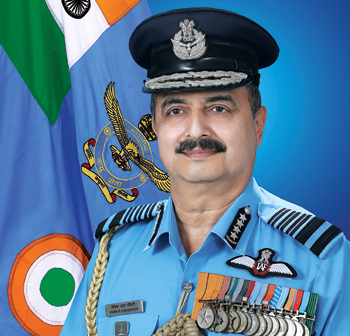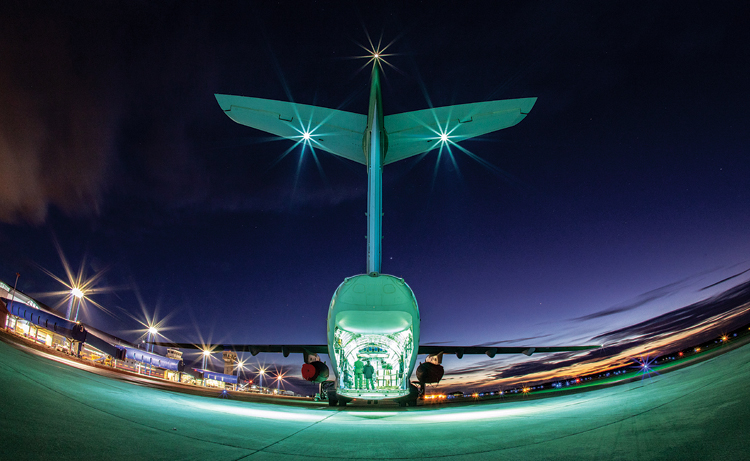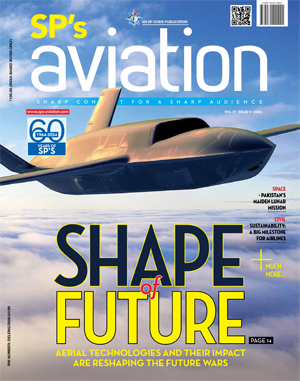INDIAN ARMED FORCES CHIEFS ON
OUR RELENTLESS AND FOCUSED PUBLISHING EFFORTS

SP Guide Publications puts forth a well compiled articulation of issues, pursuits and accomplishments of the Indian Army, over the years

I am confident that SP Guide Publications would continue to inform, inspire and influence.

My compliments to SP Guide Publications for informative and credible reportage on contemporary aerospace issues over the past six decades.
Next Gen Military Technologies
In future wars, the one who controls air and space will control all operations in the air, on surface and sub-surface

Combat aviation has become the most preferred means of prosecution of war and has seen the fastest growth in combat aviation technology. The combat aircraft features include agility (speed, manoeuvrability), precision weapon delivery at long ranges, and the ability to secure from enemy air and surface threat. Dr John Stillion conducted a detailed analysis of air-to-air combat, using a database of over 1,450 air-to-air victories in different conflicts, starting 1965 to 2015. It emerged that the need for combat manoeuvring with high rates of turn was less consequential, and to attain air superiority, the future airborne platforms will require sensors that can detect farther, aerial weapons with longer reach and ability to operate in intense electronic warfare environment. Thus, stealth, integrated sensors, secure data-linked communications, and electronic warfare suites would be more important. The one who controls air and space will control all operations in the air, on surface and sub-surface. Investments in Intelligence, Surveillance, and Reconnaissance (ISR), Directed Energy Weapons (DEW), hypersonic platforms and weapons, cyber warfare capabilities, and Artificial Intelligence (AI) would be required to outdo adversaries.
IAF CHIEF ON FUTURE WARS AND TECHNOLOGIES

At a recent seminar organised by CENJOWS, Air Chief Marshal V.R. Chaudhari, Chief of Air Staff, Indian Air Force observed, “Crystal gazing into the future, penetration by stealth platforms and low cost drones, rockets and hypersonic projectiles will challenge our detection and interception capability. Thus, there is further research required in the field of persistent, multi-spectral, all weather surveillance from space based assets. We need to also look at the capabilities of HALE and MALE RPAs to fill the surveillance voids. For destruction, we need to invest in technology such as Directed Energy Weapons, Laser dazzlers and multiple weapon systems to take on MIRVs and hypersonic missiles. Whilst we must develop this niche technology, we must also look at enhancing existing point and area defence capability by developing both, Close in Weapon Systems as well as medium and long range SAMs. There is an overarching requirement to build a layered, responsive and wide spectrum integrated model which can provide comprehensive solutions against hostile aerial and space threats.
Future wars would be multi-domain in nature and attacks on critical information infrastructure cannot be ruled out. While, there is continuous focus on networking, we must also develop the capability to operate in an environment of denial. Towards this, hardening of our grids and creating robust, redundant networks will prove to be decisive. We must jointly rehearse our operational plans in an environment of denial to ensure there is minimal disruption in our tempo of operations.”
NEXT GENERATION FIGHTERS
The future fighter aircraft will have to adapt to newer technologies for air-to-air capability, survivability in contested well defended environment, and yet deliver arsenal for effect-based results. Stealth will remain a feature. The must flexibility to undertake mixed manned and unmanned missions, and simultaneously integrate with host of data-linked sensors across domains and terra-firma. Intelligent usable data without information overload often termed“data-to-decision” (D2D) capability will be crucial. This will greatly enhance situational awareness, operational reach, and survivability. The aim is to have capability to counter next generation adversary platforms using electronic measures through own integrated next-generation capabilities.
Typical design characteristics would include high data handling and processing capability and processing over secure networks with high-bandwidth. AI will support multiple data assessment and high speed decision making. The situational awareness will be greatly enhanced through advanced human and systems integration. Helmet-mounted or even eye-retina displays will endeavour to give the pilot and systems operator an all hemisphere picture, allowing more complete threat assessment and attack/response options.
The new aircraft will feature next-generation avionics, more efficient thrust-vectoring engines with in-built super-cruise, advanced stealth features, conformal weapon bays with extended long-range weapons with high degree of post-launch autonomy. Improved on-board power generation and capacity to support powerful electronic warfare systems and DEW. All systems will talk to each other. The aircraft will have a powerful health monitoring and diagnostics suite and self-healing options. At the design board stage itself the airframe shaping, composite materials, emissions absorbing paints, engine inlets, and all emitters will support low radar cross section (RCS) over cross-section of all frequencies without trading any flight performance.
Plug-and-play interchangeable hardware will have appropriate software. 3D tools will be used for both design and manufacture processes. The sixth-generation fighters would have self-healing structures, breakthroughs in propulsion, materials, power generation and weapon technology.
AERIAL WEAPONRY AND COUNTERS
Future aerial engagements dictate sensors with long range detection and missiles cruise farther and have high no escape zones. Russia has already become the first to use the hypersonic missile in combat in Ukraine. USA, and China have advanced hypersonic weapon programmes. India too is working on such weapons. US Air Force along with Raytheon is working on a mini-missile that an aircraft could use to shoot down incoming air-to-air and surface-to-air missiles as part of the Miniature Self-Defense Munition (MSDM) programme. New turret systems are being designed to allow high-energy lasers to engage enemy aircraft and missiles above, below and behind the aircraft. High-energy laser weapon pod for fighters are being designed to protect from missiles. The US Air Force Research Laboratory (AFRL) is developing a fibre laser system called Self-protect High Energy Laser Demonstrator, or SHiELD. It could take-on incoming missiles or even daze or burn electronics of other airborne platforms.
UNINHABITED AERIAL SYSTEMS (UAS) AND COUNTERS
Drones and uninhabited systems are already flying in large numbers and more action in unfolding. Dual use (optionally manned) aircraft are evolving. Autonomous UAS are operating from aircraft carriers. Next generation UAS will be able to take an all roles on Strike, air defence, aerial refuelling, and air delivery roles. By mid-2040’s, it is envisaged that every aerial mission could be flown unmanned. Aerial drone swarms operating in mutual coordination, flying synchronously, and performing operational tasks has been repeatedly demonstrated, including by Indian manufacturers. The swarm could overwhelm the defences by numbers. Drone counters include both“hard kill” and“soft kill” are already evolving. These could be small arms fire, electro-optical weapons such as lasers, data-link jamming, electronic or cyber-attack, and directed energy weapons like microwave. A drone swarm may be engaged by a counter drone swarm.
FUTURE PILOT SUPPORT SYSTEMS
Smart drugs and hybrid supplements increase endurance, stamina, physical strength, and alertness levels and regulate the sleep and waking hours and pilot could keep awake for days. Modified genes will convert fat into energy so as to last for long flights. A trans-dermal nutrient delivery system will provide just enough nourishment to keep the body going. Pilot’s physical and mental state will be monitored by sensors to check overload, physiological stress and the same transmitted to ground controller. Light-weight helmets with visor displays for integrated information from all sensors for weapon cueing and shoot command. Next-generation helmets will pick up vibrations from the skull and transmit sound directly into the head instead of using traditional microphone-earpiece combine.
CAMBER CONTROLLED WINGS
New materials are continuously being developed. Flexible aerofoil concepts are evolving. It will be possible to change the profile of the wing during flight by rotating the flexible edges. The traditional aircraft flaps are being replaced by a torsional wing surface that could make large twisting movements to alter the lift and drag for take-off and landing. Natural elasticity of aviation-grade materials would be used. Actuators and sensors would be used to create computed wing deformations. The wing does not require the traditional control surfaces.
MODERN AIRBORNE RADARS
Modern AESA radars should be able to operate in heavy Electronic Counter Measures (ECM) environment. In order to reduce the size, weight, power and cost of AESA radars, small computercontrolled solid-state transmit/receive module (TRM) are put together in an array, using multiple-input multipleoutput (MIMO) technology. AESA brings beam forming and beam steering agility thus permitting better tracking of very fast supersonic cruise missiles and aircraft. Antenna can also take on multiple tasks at the same time. To avoid the spectrum congestion at lower microwave frequencies, many applications have moved beyond 20 GHz. Millimetre wave radars can give much better resolution because of ultra wide bandwidths, and lower ground clutter, and they also give the benefit of smaller size. Radar components are nowadays 3D printed. Modern AESA’s use Gallium Nitride, or GaN power transistors that are able to operate at higher power levels and higher frequencies, more efficiently.
Next generation UAS will be able to take an all roles on Strike, air defence, aerial refuelling, and air delivery roles. By mid-2040’s, it is envisaged that every aerial mission could be flown unmanned.
INFRARED SEARCH AND TRACK (IRST)
Unlike radars, IRST systems are passive, and do not radiate, and as such don’t expose own location. Hence the system is dependent on energy emitted by the target, the detection range is not as high as a radar. Current technology typically allows detection ranges of as high as 100 km. The IRST is connected on the data sharing bus, and sensor data can be shared with other sensors on-board the aircraft or with external platforms or the ground control. The new concept is to have a universal podded IRST. It gives flexibility to match the sensors to the mission quickly.
AIRCRAFT DIAGNOSTICS AND REPAIR
Aircraft health monitoring is crucial activity. Modern systems use real-time data from multiple sensors that are fully integrated. They are further connected to the fleet data bases through Wi-Fi or Satellite communications. The systems are combined with machine learning, IoT-enabled sensor technologies, and other sophisticated data processing systems. They incorporate fault diagnostics using artificial intelligence. Technology will allow predictive maintenance solutions. Online realtime monitoring reduces turn-around maintenance time, and improves aircraft utilisation rate. It could in the long run reduce the ‘Life Cycle Cost’.
With greater usage of composite, self-healing materials, that react to a situation somewhat akin to the blood clotting or adrenaline rise in the human body and repair the damaged areas. A pocket of epoxy resin and a hardener, could be installed near pre-assessed vulnerable parts of the aircraft airframe. At the time of damage, the contents of the pocket could be automatically or manually released to fix the crack or damaged.
ARTIFICIAL INTELLIGENCE (AI)
Artificial Intelligence (AI) supports autonomous operations, and intelligent navigation. AI helps in high speed multitasking. It supports weapon selection and firing solutions. AI enhances flight safety. Human-AI teaming would help enhance multi-layer capabilities for handling many undefined combat situations in hostile environment. AI also supports multiple aircraft/drone swarms.
JET ENGINE TECHNOLOGY
Future engine technologies must support reduced development cycle, evolve means to reduce engine weight, improve engine propulsive efficiency and better SFC, improve reliability and maintainability, and reduce life cycle costs. The gas turbine engine technologists have been working on increasing compressor pressure and engine bypass ratios to improve pressure recovery. New materials would be lighter and withstand higher temperatures. Better turbines machining would also reduce weight and blade balance. The carbon-fibre blades are being used. Full computer controlled“smart engines” and use of magnetic bearings, will also improve engine operations. Additive 3D manufacture will reduce production time and cost. It will also reduce maintenance time. The variable cycle engines are so programmed that it selects the highthrust mode when maximum power is required, as during Takeoff or fast acceleration, and high-efficiency mode during cruise for fuel savings and best range. Full Authority Digital Engine Control (FADEC) is when a computer manages aircraft ignition and engine control system to control all aspects of engine performance digitally. The future is in increased use of electrical power for aircraft propulsion and various subsystems. Hybridelectric aircraft are already evolving.
NEXT GEN MILITARY TRANSPORTS
The next generation military cargo planes are already being contemplated. A larger vertical and/or short take-off and landing (V/STOL) tactical airlift aircraft will ensure quicker operational access. Assessing a potential adversaries’ emerging antiaccess and area denial (A2/AD) threats. These will allow ability to project and sustain force into intermediate staging and forward operating bases. The C-130 class aircraft will have to be replaced by 2030-2040. Key features required are larger basing options, quick reaction deploy-ability, significant reach, smarter tactical logistics, and greater surprise through deception, and stealth. The future V/STOL would have to be larger than the C-130 to be able take similar or larger load. DARPA’s VTOL X-Plane prototype improves on the V-22 concept. The project seeks to design an unmanned demonstrator that flies 300-400 knots, raises hover efficiency from 60 to 75 per cent, doubles the lift-to-drag ratio to at least 10, and has a 40 per cent load factor. The aircraft would have to double as airlifter-cum-tanker. The concept would require“advanced theatre airlift platforms, to manoeuvre and sustain operationally significant, combat-configured, medium-weight mounted forces. It will have to increase the deployment speed, offensive capability, and survivability of the Global Response Force (GRF) from a strategic distance. A 5,000 unrefuelled nautical mile range will allow crossing all oceans. An electric power plant could increase the C-X’s range to anywhere in the globe. C-X would be air-refillable. The C-X must radar and missile warning sensors, and defend with expendables or electronic jamming using large aircraft infrared countermeasure (LAIRCM). It must ability to provide the drew situational awareness to fly low altitude in instrument conditions without reducing delivery capability.

MODERN COCKPIT TECHNOLOGIES AND CONCEPTS
The modern cockpits use electronic displays, and are often referred to as glass-cockpits. The display screens are re-configurable for crew convenience and stage of flight. Most traditional controls are replaced by multi-function“soft keys”. The stick and throttle now have many controls, and are termed the“Hands on Throttle and Stick” or HOTAS controls. Modern cockpits also have the Helmet Mounted Sighting System and the Direct Voice Input (DVI) to reduce pilot’s head-down work. Head Up Displays (HUD) systems use a scanning laser to display images or videos on a transparent medium. Newer micro-display imaging technologies are evolving. Virtual retinal displays (VRD) are also evolving.
AUTOMATIONS SAFETY MANAGEMENT
Automation in modern cockpits supports many flight assist features. They help reduced-visibility take-offs, and landings. It also supports multiple systems monitoring and failure alerts and remedial pilot actions. Automation also assists system health diagnostics. It also relieve pilots from boring repetitive tasks and allow crucial parameter monitoring. The negative fallouts of automation are that it results in declining pilot flying skills. Automatic system disengagement due to failure state may be missed by the aircrew and have adverse consequences. Diagnostic systems have limitations for dealing with multiple failures and there may be situations that may require deviations from pre-fed Standard Operating Procedures (SOPs). Unanticipated situations requiring manual override of automation and can induce peaks of workload and stress. Automation dependency, inadequate systems knowledge and a lack of manual flying and aircraft management competence are a deadly cocktail combination. Automation failure may also take the aircraft to a flight state from where it will become more complex for pilot to recover. Many pilots get so used to automation, that they may become reluctant to take over manually. A 2013 report by the FAA found that in more than 60 per cent of 26 accidents over a decade involved pilots making errors after automated systems abruptly shut down or behaved in unexpected ways.
TO SUMMARISE
Militaries will keep driving technologies. Future technologies will support more wireless systems. Robotics and AI will make a huge difference in times to come. Future warfare will increasingly be through uninhabited systems. Lighter, longer lasting batteries will greatly support automation. Tele-presence will support single-pilot operations, and along with AI it will keep enhancing decision making. AI will also support actions to prevent catastrophic events or accidents. 360 degree virtual-reality systems will help improve situational awareness. 5G technologies will make things even faster, which will be crucial for large volume of data exchange. There will be much improved cloud-based voice“Alexa” type service. Increasing urban air mobility will seek navigation and traffic safety solutions. Miniaturisation will continue in more areas. Sensors and weapon ranges will be important. Weapon precision would increase further.





